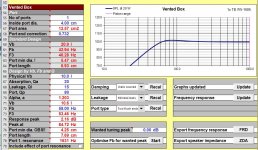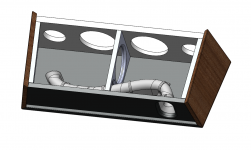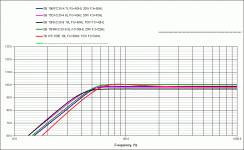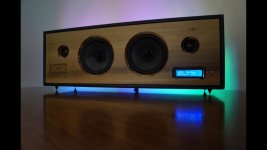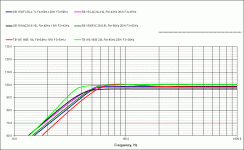The reason I asked is because that's slightly less than optimal. Without a sub and without being able to get down to the lower frequencies of most music (40Hz), it's often best to get a FR that gives you a little boost around 80Hz. By emphasizing the 1st harmonic of 40Hz this gives the illusion of more bass than is actually being produced. But with your size limitations, you aren't even getting that.
I haven't used it but from what I've heard that TB is a pretty decent driver. But the way that you are using it doesn't really take advantage of some of its best qualities. So I'm wondering how committed you are to that driver or are you open to other options that are designed to work better in smaller boxes?
I haven't used it but from what I've heard that TB is a pretty decent driver. But the way that you are using it doesn't really take advantage of some of its best qualities. So I'm wondering how committed you are to that driver or are you open to other options that are designed to work better in smaller boxes?
I do already have 2 of those TB drivers purchased so would prefer to use them if I can do but would still be open to hearing about other options. I think potentially the best option at this point may be to extend the design of the enclosure so it has a larger internal volume as it hasn't yet been physically made. I can experiment to see how large it needs to be to get this boost at 80Hz and see if the thing still looks okay and in proportion. The amp I've developed can put out 50W per channel.
W5-1685 - QTS of .46 is better served in a sealed box but can be used for ported, but not ideal, low bass extension would be fine with the right box volume.
With Two of these in 14L my plan would be sealed and active with some EQ to extend the bass, just find the volume limit with 6.5mm xmax each.
With Two of these in 14L my plan would be sealed and active with some EQ to extend the bass, just find the volume limit with 6.5mm xmax each.
Last edited:
Joel's idea isn't a bad one but looking at the sims in Unibox, the sealed version is going to be more limited in SPL because of the xmax limitations. Ported gives the added SPL's without the same cone excursion.
Below is what I'm thinking of in terms of the ported 80Hz boost. That's 10L per driver now tuned to 58Hz. You'll have to tell me if that's too significant of a size increase.
I've been looking at some nice SB Acoustic 6" drivers that work well in smaller boxes. I'll have another look.
Below is what I'm thinking of in terms of the ported 80Hz boost. That's 10L per driver now tuned to 58Hz. You'll have to tell me if that's too significant of a size increase.
I've been looking at some nice SB Acoustic 6" drivers that work well in smaller boxes. I'll have another look.
Attachments
Thanks for delving into it. I too found my simulations to also look better ported. I currently have a 44cm port with a 3.6cm x 7.8cm diameter. I have taken inspiration from the Muso Naim who also use a large BRP to get a good response in a similarly sized package as mine (although they have a 450W amp with active crossovers so this is probably a poor comparison to make). Currently the hardware I have ready for this is my amplifier PCB with 50W per channel, 2x TB W5-1685 and the SEAS tweeters (but I haven't yet purchased these). I could potentially manage 10L per driver, although from my simulations it looked better when they shared the enclosure space rather than partitioning?
I've included a couple attachments showing the internals of the design thus far. I have already 3D printed the BRP but I might have been jumping the gun there from the looks of things. Realistically I couldn't see the internals being much more than 16,000cm^3 maybe 18 at a push. After that moving the thing around from room to room becomes difficult. Doesn't stuffing the unit with some kind of filler help in these regards though?
I've included a couple attachments showing the internals of the design thus far. I have already 3D printed the BRP but I might have been jumping the gun there from the looks of things. Realistically I couldn't see the internals being much more than 16,000cm^3 maybe 18 at a push. After that moving the thing around from room to room becomes difficult. Doesn't stuffing the unit with some kind of filler help in these regards though?
Attachments
Again, cool design. You've obviously put a lot of time and effort into this already so I don't want to rain on your parade. And I haven't personally built anything like this so I may not be the best person for advice for some details. Nevertheless, a couple of problems spring to mind.
I would fully partition the 2 drivers. Left and right will have different signals going to each so if 1 is getting bass and the other is not, the other driver may act as a passive radiator and that will screw up the box tuning. In theory anyways. In practice, I don't really know how detrimental that may be. If you do partition, you will of course need 2 ports.
If the plan is for the speaker to be placed up against a wall, having the port feeding out the back is less than optimum. But with that gorgeous design on the front baffle, I guess the sides would be the only alternative.
Slot ports may be a good alternative way to go when space is tight because by using some of the existing cabinet walls for the ports, they may take up a little less internal volume. You'd have to do the calculations to be sure though.
I'm not sure if the angled sides (on 2 planes I think?) are for function or form, but in terms of the footprint that the speaker will occupy, it is kind of a waste of space. Might be ok though if the driver you choose doesn't need a larger box.
I might add 2 small vertical braces right about in the middle of those 2 top sub-panels to help prevent resonances. Those will be the worst offenders.
Actually, stuffing a vented box helps in other respects but will actually reduce the LF output a little bit. It helps more in a sealed box. Usually the walls are lined in a vented box and maybe some polyfil type insulation to help absorb some of the midwoofer's higher frequencies but you also need to make sure there is an open path between the drivers and the port.
I would fully partition the 2 drivers. Left and right will have different signals going to each so if 1 is getting bass and the other is not, the other driver may act as a passive radiator and that will screw up the box tuning. In theory anyways. In practice, I don't really know how detrimental that may be. If you do partition, you will of course need 2 ports.
If the plan is for the speaker to be placed up against a wall, having the port feeding out the back is less than optimum. But with that gorgeous design on the front baffle, I guess the sides would be the only alternative.
Slot ports may be a good alternative way to go when space is tight because by using some of the existing cabinet walls for the ports, they may take up a little less internal volume. You'd have to do the calculations to be sure though.
I'm not sure if the angled sides (on 2 planes I think?) are for function or form, but in terms of the footprint that the speaker will occupy, it is kind of a waste of space. Might be ok though if the driver you choose doesn't need a larger box.
I might add 2 small vertical braces right about in the middle of those 2 top sub-panels to help prevent resonances. Those will be the worst offenders.
Actually, stuffing a vented box helps in other respects but will actually reduce the LF output a little bit. It helps more in a sealed box. Usually the walls are lined in a vented box and maybe some polyfil type insulation to help absorb some of the midwoofer's higher frequencies but you also need to make sure there is an open path between the drivers and the port.
Attached is a comparison of some of SB Acoustic 150mm drivers. I have them all set up at their maximum cone excursions for content down to 40Hz so you can see their max SPL's and how many watts it takes to get there.
Quality is at least as good as the TB W5. The CAC ceramic and the NAC aluminum drivers go the lowest. The others will play a little louder. The poly cone MFC gets it done in the smallest box. Some of those responses can be modified to give similar to the TB W5 in even slightly smaller boxes.
The TB is there too for comparison purposes. A little messy because of overlap but there you go.
Quality is at least as good as the TB W5. The CAC ceramic and the NAC aluminum drivers go the lowest. The others will play a little louder. The poly cone MFC gets it done in the smallest box. Some of those responses can be modified to give similar to the TB W5 in even slightly smaller boxes.
The TB is there too for comparison purposes. A little messy because of overlap but there you go.
Attachments
Interesting theory on the two drivers, and something I will probably experiment with once I've got the thing made. The majority of music seems to be mixed centrally especially in the bass department so my hope was it wouldn't be too much of an issue. I have made a similar speaker in the past but that was sealed.
Will have a rethink on the port, I think potentially building a quick and dirty MDF mock-up to try things like the port and stuffing would be a good idea.
Yes the whole speaker tapers off towards the back purely for aesthetics, the previous unit (image was attached) was rectangular front to back which is fine but not as exciting to look at.
Definitely right on the bracing, will add those in.
Thanks for the simulations, very useful. In your simulation I see it's at 10L and you're getting a pretty good response from the TBs whilst in range of my amps capability (much better than my simulation). What port are you using? Also how does this change in your sims with 20L and two of them? I am using WinISD for mine and this has a big effect.
Will have a rethink on the port, I think potentially building a quick and dirty MDF mock-up to try things like the port and stuffing would be a good idea.
Yes the whole speaker tapers off towards the back purely for aesthetics, the previous unit (image was attached) was rectangular front to back which is fine but not as exciting to look at.
Definitely right on the bracing, will add those in.
Thanks for the simulations, very useful. In your simulation I see it's at 10L and you're getting a pretty good response from the TBs whilst in range of my amps capability (much better than my simulation). What port are you using? Also how does this change in your sims with 20L and two of them? I am using WinISD for mine and this has a big effect.
Ok, good to know you have thought about all that.
TB W5 in 10L needs a 4cm x 7.7cm port. That's right about at max speed before chuffing is a problem. In 20L it does a whole lot better. The port contributes more to the LF response so it can play louder now before xmax is reached with about 25W. Port needs to be bigger though, 5cm x 13.8cm. F3 is now 38Hz.
Each example is for 1 driver only. For 2 drivers together in 40L, you need 2 of the same ports or 1 port about 7.5cm x 14cm. That's according to Unibox anyways and using TB's specs.
TB W5 in 10L needs a 4cm x 7.7cm port. That's right about at max speed before chuffing is a problem. In 20L it does a whole lot better. The port contributes more to the LF response so it can play louder now before xmax is reached with about 25W. Port needs to be bigger though, 5cm x 13.8cm. F3 is now 38Hz.
Each example is for 1 driver only. For 2 drivers together in 40L, you need 2 of the same ports or 1 port about 7.5cm x 14cm. That's according to Unibox anyways and using TB's specs.
Attachments
Okay thanks for all your help. I'll have a play around and try make things bigger where possible and see how it goes.
My pleasure.
I'll just add just in case I misunderstood your question - 2 of the TB W5's in 20L tuned to 58Hz needs 1 port about 6cm x 7.5cm.
Let me know if I can be of any further help.
I'll just add just in case I misunderstood your question - 2 of the TB W5's in 20L tuned to 58Hz needs 1 port about 6cm x 7.5cm.
Let me know if I can be of any further help.
Small vcad tip. Select your driver and press Ctrl-I . That inverts the polarity so you can toggle to check phase alignment via frequency response if targeting an even order slope crossover. Instead of waiting the driver upside down.
Sorry to revive this old thread, just quick one. Do you count the air inside your port/s as air which contributes to your box volume?
- Home
- Loudspeakers
- Multi-Way
- 2-Way Crossover Design
